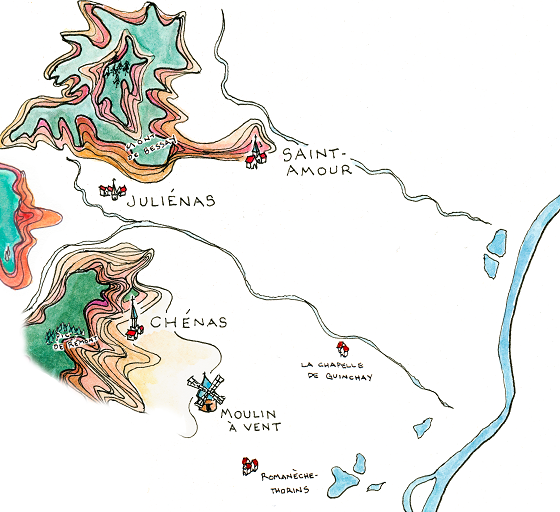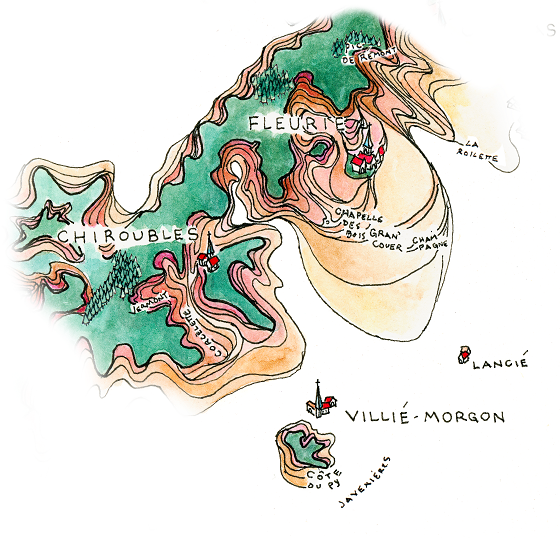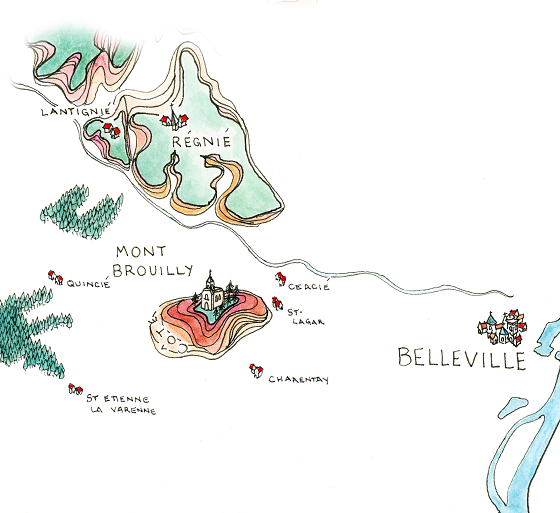A Beaujolais that falls in the pantheon of the most delicious, and greatest, wines in the world? Written by Pascaline Lepeltier, MOF 11/18/2020 The Crus du Beaujolais - Part 3 of 3 In the north, couple of crus are astride between the southern part of the Macônnais and the Beaujolais itself : Saint-Amour, Juliénas, Chénas and Moulin-à-Vent have a different profile because of this double identity, as well as very complex variations of soils not easy to pin-point.
Map by James Sligh, Children's Atlas of Wine Saint-Amour is the northernmost with its 310 ha located in the commune of Saint-Amour Bellevue. If the name is said to come from a Roman soldier turned missionary, it is without a doubt a very powerful marketing tool for Valentine’s Day. Yet, Saint-Amour is not per se the most gentle of the crus. Most of the vineyards are located between 650 to 1300 feet on the sides of the Mont de Bessay, with pretty hard-core slopes in the north, more gentle on the southeast. There is not as much pure granite as one would think: you find in the north more schists and volcanic bedrock, and in the south some altered basalt and pierres bleues, the blue-green diorite like in Juliénas, Côte de Brouilly or Morgon giving the wines of this area a lot of personality. 50% of the vineyard is on old colluvial, with more or less large stones, like in the lieu-dit “La Folie”. Overall, the wines have some freshness and lift, but with surprisingly more structured tannins. Many of these wines are well made for aging. Terroir: 48% colluvial (piedmont), 22% granites, 9.9% diorite (pierres bleues / blue stones), and some limestone, marl and clay (giving interesting Chardonnay) Main lieux-dits : Côte de Besset, Les Champs Grillés, Le Clos de la Brosse, Le Clos de Guillons, Le Châtelet, Le Clos des Billards, Les Bonnets, Le Mas des Tines, Vers l’Eglise, En Paradis, La Folie, Le Clos du Chapître Top producers: More natural: Georges Descombes, Château des Rontets (based in Pouilly-Fumé), Christophe Pacalet (négoce) More classic: Domaine de Fa, Domaine de la Pirolette Terroir: 42 % diorite (pierres bleues / blue stones), 29% colluvial (piedmont), 14% schists, 3% granites Main lieux-dits : Les Capitans, La Bottière, Les Mouilles, Vayolette, Les Fouillouses, Beauvernay, Bessay, En Rizière, Bois de la Salle, Cotoyon Top producers More natural: Smith-Chapel, Yann Bertrand, Christophe Pacalet (négoce), Rémi Dufaitre More classic: Château de Julienas, Armand Heitz, Domaine des Marrans Terroir: 49% piedmonts, 47% granites, the rest is diverse Main Lieux-dits : Aux Bois Retour, Les Brureaux, En Rémont, Les Journets, Les Gandelins, Les Melardières, Les Daroux, En Perelle, En Nervat, Aux Blémonts, Les Paquelets, Les Boccarts Top producers: More natural: Anthony Thevenet, Damien Coquelet, Domaine Thillardon, Famille Dutraive (négoce) Christophe Pacalet (négoce) More classic: Domaine Piron-Lameloise, Domaine des Pierres, Domaine des Bruyères, Yohan Lardy The cru owes its name to a real windmill built in 1550 still standing at 278 m elevation (it was recently renovated by its owners, Denis Chastel Sauzet from Château Portier), and not to a village like all the other crus. Its 640 hectares stretch over two communes, Chénas and Romanèche-Thorins. Until the beginning of the 20th century, some wines were sold under the name “Vins de Thorins”, from the most famous lieu-dit of the area. Moulin-à-Vent was the first cru in 2009 to undertake the geological survey of its terroir to understand the complexity of its 71 historical lieux-dits. The vineyards are neither the highest nor the steepest of the Beaujolais, sprawling from 500 feet up to 1500 on gentler slopes and mostly east facing. The main hill shared with Chénas is the Pic de Rémont where you find the highest climate-Rochegrès. On the western part, especially on the top, you have some pink and red granite with a lot of quartz called “Granites de Fleurie”. Some looking like bacon are nicknamed “lard”. On the eastern part, you will find flatter, colluvial soils mixing altered granite, clay and alluvial - overall heavier soil than in Saint-Amour, Chénas or Chiroubles where you have more sand mixed in these young alluvial-colluvial terroirs. Clay gives broader wines. For centuries, manganese was extracted from a mine located in the heart of the AOC. It is said to give a specific taste and structure to the wines, but one should be careful when making a direct link between this mineral compound and the organoleptic profile of the wines. Moulin-à-Vent tends to be the cru with the most similitude to Burgundy, because of a longer use of traditional maceration instead of the carbonic and semi-carbonic maceration. It is also not by chance that you find Burgundy producers involved here, like Château des Jacques owned by Jadot, or Thibault Liger-Belair. Aromatically, the wines also lean more on the wild red fruits profile, very floral (iris), with some structured tannins but not too edgy - definitely meant to age up to 20 years and more in good vintages. Terroir: 53% granites, 37% piémonts, some limestone, sandstone, marls Main lieux-dits (71) : Aux Caves, Au Michelon, Les Vérillats, Champ de Cour, La Rochelle, Rochenoire, Le Moulin à Vent, Les Thorins, La Tour du Bief, Le Dime Top producers: More natural: Michiel Guignier, Julie Balagny, Domaine Th. Liger-Belair, Christophe Pacalet (négoce), Mee Godard, Ophélie Dutraive More classic: Château des Jacques, Paul Janin, Isabelle & Bruno Peraud, Yohan Lardy, Domaine de Prion, Domaine du Vissoux, Domaine des Terres Dorées, Château de Moulin-à-Vent, Jules Desjourneys
Map by James Sligh, Children's Atlas of Wine Fleurie became within the last 20 years one of the most known, and sought for, crus du Beaujolais, and for multiple great reasons! This region is home to remarkable terroir and fantastic vignerons, producing very harmonious wines which combine both lifted elegance and serious density (for me, not unlike Chambolle, Volnay or Barolo). Located southwest of Moulin-à-Vent, its 860 ha are higher up, with steeper slopes on the west (up to 50%!!), flatter plots on the east and varied expositions everywhere. The western backbone of this cru is a range of famous hills and peaks, including the Fût d’Avenas (2,200 feet), where the winery of Julien Sunier is also located. The Colline de la Madone, created from the same geological phenomena that these peaks, offers a stunning point of view of Fleurie : at 1,300 feet, you can contemplate most of the appellation and understand its fantastic potential. Finally, we have a cru whose terroir is mostly composed of granite! It is so specific it has its own name, the pink “Granite de Fleurie-Odénas”, and it covers 90% of the AOC (in its pure form or weathered). Only Chiroubles is more granitic (at 100%.). Overall the soils of Fleurie are quite coherent, the only variation to be found is the depth of the topsoil and the elevation/exposure on the western part (like in La Madone, Les Labourons or En Rémont), and the amount of clay on the southeastern sector (like in Champagne or Grand’Cour.) Most of the piémont vineyards are composed of sand with little clay from the alteration of the granite.They are lighter soils, giving more uplifted wines than in Chénas or Moulin-à-Vent. All in all, the wines can be superb! The fruit tends to always have a freshness at its core, a lot of violet and herbal hints. The structure is subtle and lavish at the same time, with a real aging-potential of 15-20 years in the best years and from the top producers - I am still enjoying some Clos de la Roilette from the early 00s and they are fantastic! Terroir: 90% pink granites rose, 9% piémont Main lieux-dits: La Madone (center), Grille-Midi (south), Les Labourons, Les Moriers, Les Garants, La Presle, La Chapelle des Bois, Champagne (southeast), La Roilette (northeast), Grand Pré Top producers: More natural: Domaine de la Grand’Cour / Jean-Louis Dutraive, Yvon Métras, Julie Balagny, Jean Foillard, Marcel Joubert, Domaine Chamonard, Yann Bertrand More classic: Clos de la Roilette, Château des Bachelards, Domaine Chignard, Domaine Lafarge-Vial (owned by the Lafarge family in Volnay), Domaine de Prion, Domaine de Fa Terroir: 100% pink granites. Main Lieux-dits: Javernand, Bel-Air, Les Ponthieux, Chatenay, Les Roches, Tempère, Fontenelle, Rochefort, Grille Midi, Les Bonnes Top producers: More natural: Smith-Chapel, Damien Coquelet, Georges Descombes More classic: Daniel Bouland, Domaine des Marrans Morgon is the second largest cru after Brouilly. This means a large variation of terroir and expression in the wines. You can have up to 3 weeks difference in picking time between the northwestern sector like in the lieu-dit Saint-Joseph at 1,500 feet elevation, and the southeastern, warmer, and flatter foothills of the Côte de Py. The majority of the vineyards are east exposed with steeper slopes on the west side, and very soft ones on the east, except for the Py. In terms of soil, Morgon is famous for its rotten stones, pierres pourries. These stones are highly weathered and altered schists and volcanic diorites with high content of manganese and iron giving deeply structured, tannic, long-aging wines with a smoky dark fruit and savory wild profile. A verb even exists to describe this flavor profile - morgonner! Most of this soil is found around the Côte de Py and Javernières in the southeastern area, yet it represents only a minority of the soil type of the AOC (only 11%). The majority is made of granite, from pure to highly decomposed, especially in the northwestern part where you have the lieux-dits Corcelette and Douby, and the southwestern area with the climat Les Charmes higher up on the hill (1,200 feet). Here the wines are more lifted, silkier and easier to approach in their youth without losing their aging potential. What matters again is the depth of the topsoil, the altitude, and the exposition of the slope. It is really quite fantastic today to be able to taste more and more single-vineyards wines of the highest quality in Morgon as it really highlights the complexity and age-worthiness that Gamay can reach depending on the terroir. As producers are expanding their ranges and offering more and more cuvées parcellaires (vineyard-designated wines)! Terroir: 51% granites, 37% piémonts, 11% diorite (pierres bleues / blue stones) & schists (rotten stones) Main Lieux-dits : Côte de Py (southeast, pierre bleues), Aux Charmes (southwest, altered granite), Grand Cras, Corcelette (northwest, granites), Bellevue, Javernières (alteration of pierres bleues at the foothills of the Côte de Py), Douby (north, granite), Aux Chênes, Château Gaillard, Fontriante Top producers: More natural: Marcel Lapierre, Jean Foillard, Jean-Paul Thevenet, Guy Breton, Domaine Chamonard, Georges Descombes, Damien Coquelet, Mee Godard, Julien Sunier, Karim Vionnet, Alex Foillard, Kevin Descombes, Jeanne Chanudet More classic: Dominique Piron, Jean-Marc Burgaud, Louis Claude Desvignes, Daniel Bouland
Map by James Sligh, Children's Atlas of Wine Régnié is the newest cru to be recognized in Beaujolais. While the others were made official in the 30s and 40s, Régnié only became official in 1988. Located southwest of Morgon, it is one of the highest (1,000 feet average) : its profile is quite close to Chiroubles in terms of brightness of fruit and acidity even though there is more soil variation. The 390 hectares of vineyards stretches over 2 communes, Régnié-Durette and Lantignié, from 600 feet up to 1,500 feet near Thulon and Les Bastys on the slopes of the Avenais mountain. Elevation definitely has a big influence. Most of the terroir is composed of decomposed pink granite with a lot of gore and sand. The soil is quite poor, producing delicate wines but able to show a lifted core of minerality when made from the oldest vines. Some areas have veins of altered volcanic silicas especially in the piedmont, producing broader expression of the Gamay. With climate change and warmer vintages, Régnié is without a doubt a cru that is conserving some freshness without losing its intricate character. Terroir: 64% pink granites, 34% piémont Main lieux-dits : La Basse Ronze, La Haute Plaigne, Les Chastys, Vallières, La Pierre, Les Reyssiers, Aux Bruyères, Oeillat, Croix Penet, Les Bois, Les Braves Top producers: More natural: Christian Ducroux, Charly Thevenet, Georges Descombes, Julien Sunier, Antoine Sunier More classic: Jean-Marc Burgaud, Dominique Piron, Nicolas Chemarin Terroir: 46% granite, 34% piémonts, 9% colluvial, 5% sedimentary soil, 4% diorite (pierres bleues / blue stones), 1% clay Main Lieux-dits : Pissevieille (north, volcanic silica), Saburin (southwest, granite), Briante, Pierreux, Combiaty, Les Platures, Les Nazins, La Roche, Les Bruyères, La Terrière Top producers: More natural: Jean-Claude Lapalu, Marcel Joubert, Domaine de la Grand’Cour, Georges Descombes More classic: Domaine du Vissoux, Château Thivin Overlapping 4 communes, all vineyards are located on slopes. It is the second steepest cru after Chiroubles, with 15% of the plots showing more than 50% steepness... but not very high (the highest vineyard is at 1,000 feet). All the sides are covered, including the west, which is one of the rare occurrences. Mont Brouilly is not really a volcano itself, but the remains of the edges of an old volcano weathered over millions of years, thus it is mostly composed of diorite, the rotten stones you find also in Morgon, and granite. The division is pretty clear though, the granite is mostly located on the western slope, and the pierres pourries on the northeastern side to the southern part. The rest is covered with more alluvial and colluvial sediments. The vineyards rich in diorite on the east facing tend to be the most favored plot, as they are protected from storms, and the higher clay content allows for better water retention They are also richer in magnesium, and less sensitive to hydric stress. It is a great terroir, with quite stable conditions for high quality viticulture, giving great ripeness while preserving freshness. They can taste like some Morgon! On the northern and western side, the wines are lighter, with less density -they taste more like a Brouilly. Once again, it is important to know where the plots are located! To quote Christophe Pacalet, with their notes of plum and their spiciness, the Côte de Brouilly “can be kept but can be drunk early too”. Terroirs: 40% schists (pierres pourries / rotten stones) & diorite (pierres bleues / blue stones), 24% granites, 20% colluvial, 12% piémonts Main Lieux-dits: Chardignon, L’Héronde (east, altered volcanic), Croix Dessaigne, Brouilly (southwest granite & volcanic), Chavannes, Le Pavé, Godefroy, Berthaudières, Côte de Brouilly Top producers: More natural: Jean-Claude Lapalu, Alex Foillard, Rémi Dufaitre, Pierre Cotton, Christophe Pacalet (négoce) More classic: Château Thivin, France Gonzalvez, Claire & Fabien Chasselay VINTAGES |




 Saving email...
Saving email...
